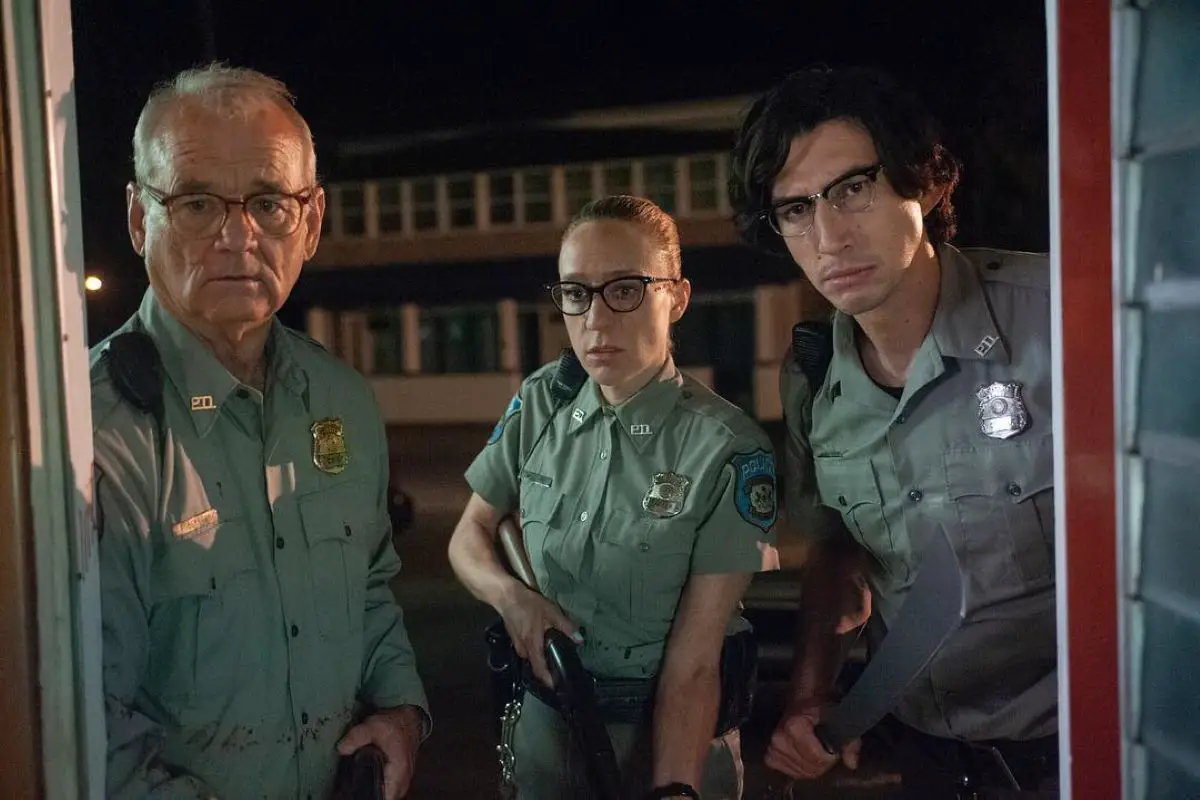More than any other ghoul, something about zombies cracks us up. For every movie about the terrified, frantic fight for survival against hordes of the undead, there are a half dozen films satirizing the exact same thing. Zombie children overrun their elementary school in “Cooties.” A zombie begins an improbable romance with a still living girl in “Warm Bodies.” The undead swarm the 19th century landscape of a literary classic in “Pride and Prejudice and Zombies.”
In the “The Dead Don’t Die,” Jim Jarmusch attempts to put his own spin on the zombie spoof, applying his signature deadpan to a genre better known for its hysterics. The result is a movie loaded with stars and weighed down by a messy, bone-dry script.
Centerville is a sleepy midwestern town, with a diner and a motel and not much else. World-weary police chief Cliff Robertson (Bill Murray) and his deputy Ronnie Peterson (Adam Driver) patrol the streets in the force’s only squad car, keeping tabs on the cantankerous Hermit Bob (Tom Waits) and debating if it’s too late for coffee and doughnuts at the diner.
But strange things are afoot in Centerville. Due to polar fracking, the world has shifted off its axis, causing the sun to stay up late into the evening, the moon to glow a menacing blue and, of course, the dead to rise.
Before long, the townspeople are embattled against a legion of zombies. Bobby (Caleb Landry Jones), who owns the local comic bookstore and is well-versed in zombie cinema, teams up with Hank (Danny Glover), whose hardware shop provides plenty of tools for bashing and chopping undead heads. Zelda Winston (Tilda Swinton), the town’s eccentric new mortician, is an expert with a samurai sword and slices her way to the police station to find Cliff, Ronnie and Officer Mindy Morrison (Chloe Sevigny).
The four agree to meet at the cemetery after the officers have patrolled the town: only Cliff and Ronnie make it, with Mindy giving herself up to the zombies and Zelda exiting in a way too outrageous to spoil. The movie ends with the two cops taking on the undead, a doomed effort that Hermit Bob watches and ruminates on from the woods.
If nothing else, Jarmusch should be recognized for creating a zombie flick with a tone and style that perfectly emulates its shambling subjects. All too often, the movie’s deadpan is just … dead. When the first two zombie victims are discovered, torn to shreds in the diner, a long scene unfolds in which each of the police officers survey the carnage, then walk out and ask the same set of questions.
https://www.instagram.com/p/Bxpof9-B5ym/?utm_source=ig_web_copy_link
What’s supposed to be a slow-burning joke is, quite frankly, just frustrating and tedious and crosses the line from dry humor to a dispiriting lack of energy. The plodding pace of the script, coupled with the determined underacting of the film’s stars, makes for a slog.
It may be that the contradiction of a deadpan zombie movie is simply irreconcilable, even for a writer and director of Jarmusch’s abilities. What works so well in a picture like “Stranger Than Paradise” — a film that relishes the mundane aspects of everyday folks’ lives — is tough to translate into a context that’s decidedly not mundane.
But troubles with tone aren’t all that hinders “The Dead Don’t Die.” Even more frustrating is the sloppy handling of characters, several of whom enter and exit the story for no apparent reason. The most glaring example is the three tweens held in a juvenile detention center, who appear in only a handful of scenes and make their getaway during the final third of the film.
Equally unnecessary are the beautiful young people from Cleveland who stop into town for the night and become zombie victims. The group is headed by Zoe, played by Selena Gomez, who’s likely making a bigger contribution to the cast list than to the movie itself.
https://www.instagram.com/p/BxxxperB5Fv/?utm_source=ig_web_copy_link
The story of precocious young kids or attractive out-of-towners being pitted against the undead is totally plausible for a zombie satire. But in Jarmusch’s film, there’s not an attempt to satirize these plotlines, so much as to vaguely gesture towards them. There’s a similar lack of effort in the presenting of themes, particularly that of zombies as a metaphor for consumerism.
The reanimated shuffle around, muttering things like “Xanax,” “guitar” and “candy.” Their hunger for human flesh is paralleled by a hunger for past material pleasures, a point Hermit Bob beats the viewers over the head with during his diatribe in the final scene.
Jarmusch is not the first to link zombies’ insatiable appetite to the drive of materialism. In his 1978 classic “Dawn of the Dead,” George Romero places his survivors in a shopping mall, where they flee the undead through department stores and a food court. It’s clear that Jarmusch drew inspiration from Romero, and there are several references to the director in “The Dead Don’t Die.” Bobby wears a “Night of the Living Dead” pin on his vest, and compliments Zoe’s car, the same model that appears in the film.
But if Hermit Bob’s monologue on the lifelessness of consumerism is meant as further homage, it comes off strangely. Its delivery is so limp and effortless that it seems almost like a parody of the kind of horror movie that tries to speak on real issues. This perhaps gets at the core problem with the movie: the deadpan is so thick and unyielding that viewers can’t be sure if at some point the irony ends and a sincere message begins.
All these flaws are a shame, because for brief moments “The Dead Don’t Die” really shines. When Cliff, Ronnie and Mindy encounter their first zombie, what’s traditionally a scene of terror and frantic fighting is hilariously subverted. Cliff puts a few rounds in her before Ronnie calmly approaches and detaches her head with a couple swings of his machete.
The other two cops look on, perturbed but not horrified. As the three stand over the body, Cliff compliments the form of Ronnie’s swing, and the two talk about Ronnie’s experience playing farm league baseball. The interaction is a reminder of Jarmusch’s gift for writing authentic-sounding dialogue, full of tangents and asides, that can work in even the most absurd of circumstances. Unfortunately, moments like these can’t overcome how suffocatingly sardonic most of the film is. At least there’s a new “Zombieland” to look forward to.
















